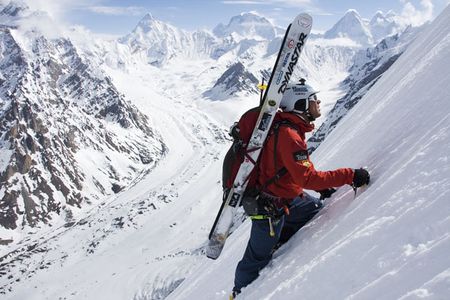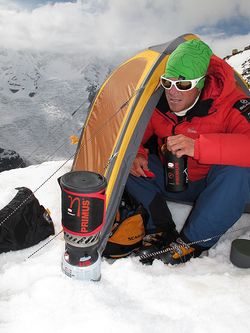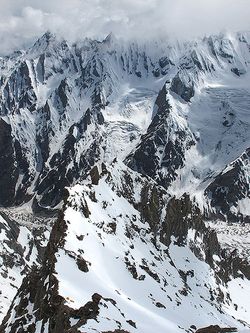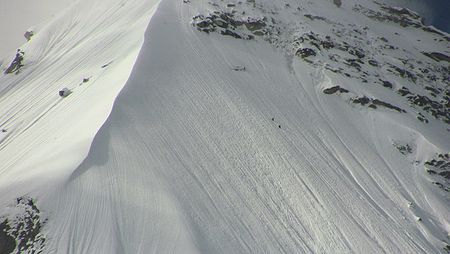
8:30 a.m. The pit, in and of itself, was inconclusive. When pressured with the kind of force that would represent a skier executing a silky smooth jump turn, a layer did, in fact, release, but it wasn’t the kind of sheer that shrinks your cojones and sends you tiptoeing for the nearest safety zone. The summit was literally straight above us; just a few more hard hours and we’d be there. On the other hand, the northwest aspect of Laila is a massive, flat and featureless 45-50-degree tabletop, and it was easy to imagine that any kind of fracture would release the entire face. It’s times like these that I find it useful to pause for a moment to reflect on my priorities in life.
After a refreshing alpine start, we’d been climbing for five hours, traversing, really, once we’d rappelled over the ‘shrund, found a semi-stable snowbridge to cross the crevasse that blocked access to the face, then traversed to the base of the rock band that guards the climber’s right. That’s when we started gunning up the central snowfield for the summit. We were making good time, thanks in no small part to the evil-looking cornice that threatened the traverse for a good couple of hours. But the higher we climbed the deeper the snow became until it was waist-deep. It felt stable, but that much snow at that angle and everything telling us there was more snow above us made those gut instincts kick in. That’s when we dug the pit to check the snow stability.

Instincts go a long way in the mountains, and the ability to tune into them is a proven skill for those who have led long and prosperous lives there. Fredrik Ericsson is a guy who’s got ’em. As one of the world’s most experienced and most active high-mountain skiers, it’s safe to say that Ericsson relies on, and is more in tune with, those gut instincts much more than your everyday 9-to-5er. Check this resumé:
July 2003–Peak Somoni, a.k.a. Pik Communism–skied from summit (7,495 meters/24,590 feet) to base camp.
September 2004–Shisha Pangma–skied from central summit (8,012 meters/26,286 feet) to green grass.
June 2005–Laila Peak–turned back 100 meters from summit when faced with 60-degree blue ice. Skied from 5,950 meters to Gondogoro glacier.
July 2005–Gasherbrum II–skied from summit (8,035 meters/26,362 feet) to the icefall above base camp.
October 2007–Dhaulagiri–along with noted alpinists Dodo Kopold (Slovakia), Kinga Baranovska (Poland), and Kim Hong Bin (Korea), Ericsson turned back when faced with deep, unstable snow. Skied from 8,000 meters/26,247 feet to base camp.
October 2008–Kangchenjunga–Turned back when confronted by heavy storms (half a meter in one day). Skied from 7,000 meters/22,966 feet to base camp.
June 2009–K2–Called off expedition after partner’s fatal accident.

When it comes to living the dream, high-alpine skiing can at times be more of a nightmare. But clearly, Ericsson’s track record proves not only his remarkable strength in the mountains but also his ability to listen to his gut and make the toughest call of all: The decision to turn back. But it is precisely that combination of sensing the ethereal, making a calculated decision, and pulling the plug that keeps a person alive to climb another day.
Of course, you’re rarely in a position for validation. It’s inevitable that for all but the most zen-tastic climber, you’ll inevitably find yourself back at base camp second-guessing your decision. Its bitterness keeps you awake at night, darkens thoughts in otherwise serene moments, makes you dwell on the difference between living life and cheating death, and ponder on which side of that particular line you’re standing when you desperately want to continue while something deep inside you is telling you to tuck tail and run.
So, yeah, we’re back at base camp, watching it snow, trying not to think too hard about anything other than why the solar panels aren’t charging the batteries. Trying to avoid eye contact with Laila. Ericsson’s clearly smitten with this Balti beauty, and after basking in her glow for a day, I can totally see why he’s fallen so hard for her. In his eyes, her coy rebuffs have done nothing but made her that much more desirable.
But we’re here on a mission, and that mission is to ski K2. Word has filtered through the porter hotline that the Gondogoro-la has just been opened by the aptly named Gondogoro Safety Team. Over on the snow-besieged Baltoro glacier the Swiss have finally persevered in the last few days to reach Broad Peak. A rumored porter conundrum has left the French just short of the normal base camp at Gasherbrum II but close enough to start working their way up. Nobody has yet made it through to K2.

It’s tempting to stay here with Laila. We’re camped on dry ground, the lake is melting, and we know that if we could just hang out for another couple of days, the sun would shine again and Laila would give us another go. But despite all this, there’s a feeling in our guts, and it’s not last night’s rice and dahl supreme. It’s K2 calling our names, and that’s a gut instinct that’s impossible to ignore. Time to piss on the fire, call in the dogs, and head ‘em on up to K2.
–Trey Cook
To see photos and videos of Fredrik Ericsson’s past expeditions and learn more about his quest to ski the world’s three highest summits, check out .